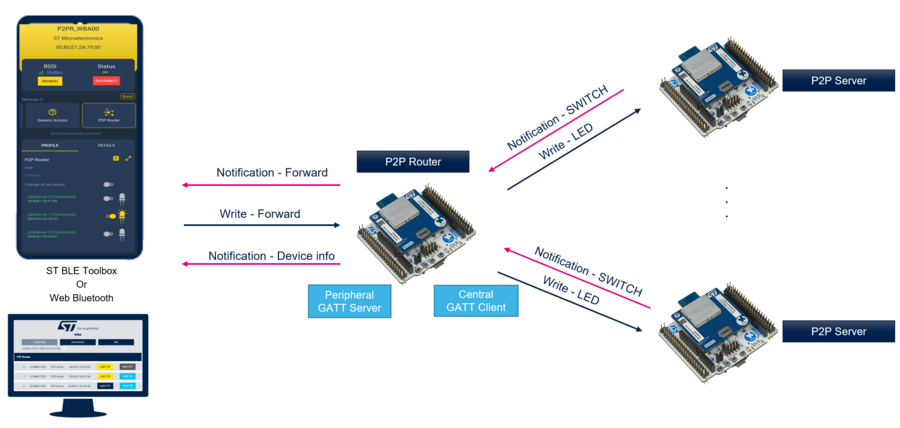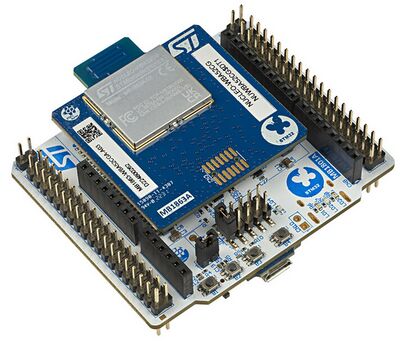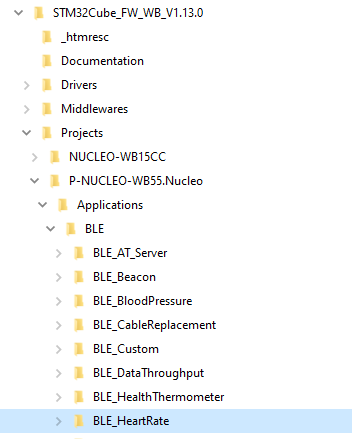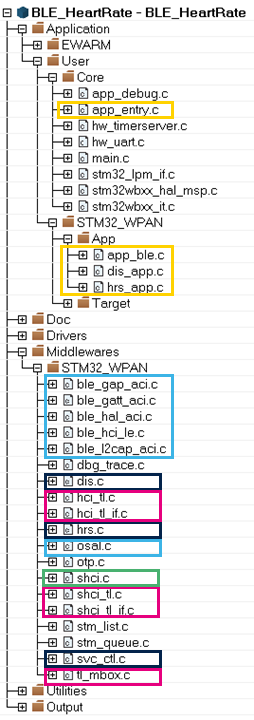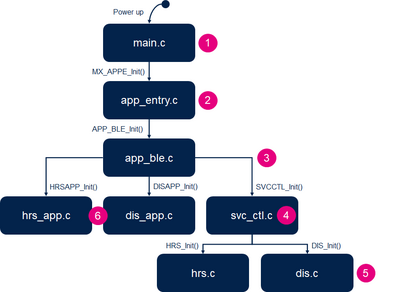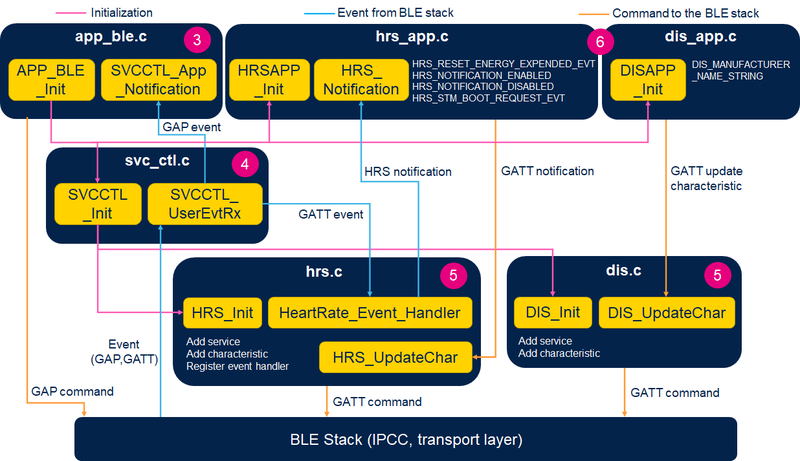1. Peer to Peer Router Topology
The Peer to Peer Router application is intended to demonstrate multi capabilities of the STM32WBA Bluetooth® LE solution. It acts as:
- GAP Central & GATT Server (P2P Router Service) device to be connected and controlled by Smartphone
- GAP Peripheral & GATT Client device to control up to seven end devices (P2P Server)
The Peer to Peer Router service is a Generic Attribute Profile (GATT) based low-energy profile defined by STMicroelectronics with proprietary UUIDs(128 bits) including three characteristics
This wiki page is the description of the Peer to Peer Router project provided within the STM32CubeWBA MCU Package[1]
| Bluetooth® LE Peer to Peer Router & STM32WBA |
|---|
The table below describes the structure of the P2P Router service:
| Bluetooth® LE P2P Router Service specification | |||||||||||||||||||||||||
|---|---|---|---|---|---|---|---|---|---|---|---|---|---|---|---|---|---|---|---|---|---|---|---|---|---|
|
Health Thermometer is exported as a Service
- Temperature Measurement characteristic (TEMM):
- send a temperature measurement, and update flags related to these.
- Temperature Type characteristic (MNBS):
- is one of two methods that are used to describe the type of temperature measurement in relation to the location on the human body at which the temperature was measured.
- Intermediate Temperature characteristic (INT):
- send intermediate temperature values to a device for display purposes while the measurement is in progress.
- Measurement Interval characteristic (MEI):
- enables and controls the interval between consecutive temperature measurements.
Device Information (DIS) is exported as a Service
- Manufacturer Name String characteristic (MANS):
- name of the manufacturer of the device.
- Model Number String characteristic (MONS):
- model number assigned by the device vendor.
- System ID characteristic (SYID):
- structure containing an Organizationally Unique Identifier (OUI) followed by a manufacturer-defined identifier and is unique for each individual instance of the product.
| Example of flow diagram between STM32WBA & ST BLE Toolbox |
|---|
2. Requirements
2.1. Software and system requirements
The software required are the following (minimum IDEs version):
- IAR Embedded Workbench for ARM (EWARM) toolchain V??
- RealView Microcontroller Development Kit (MDK-ARM) toolchain V??
- STM32CubeIDE toolchain V?? [2].
Programmer:
- STM32CubeProgrammer[3] : To flash the board with an already generated binary
2.2. Hardware requirements
NUCLEO-WBA5 [4] is necessary to install the application.
| Hardware platform illustration |
|---|
|
|
2.3. Collector applications compatible
The STM32CubeWBA Health Thermometer Sensor project is compatible with the following collector:
3. STM32WBA Health Thermometer Sensor example description
3.1. Project directory
The "BLE_HealthThermometer" application is available by downloading STM32CubeWBA MCU Package[5].
| Heart Rate project directory |
|---|
3.2. Project description
3.2.1. Structure
Software project structure with the most important parts:
| Heart Rate project structure |
|---|
|
WARNING: Do not modify the files in Middlewares folder |
3.2.2. Application initialization
The different steps of the application initialization are described below:
| Heart Rate project initialization |
|---|
3.2.3. GAP and GATT initialization and interaction
The Bluetooth LE Heart Rate Sensor application initialization is done within app_ble.c
- Start the BLE stack - initialize the device as peripheral - configure and start advertising: ADV parameters, local name, UUID - APP_BLE_init()
- Call the services controller initialization SVCCTL_Init() - svc_ctl.c
- Manage the GAP event - SVCCTL_App_Notification()
- EVT_LE_CONN_COMPLETE - provides information of the connection interval, slave latency, supervision timeout
- EVT_LE_CONN_UPDATE_COMPLETE - provides the new information of the connection
- EVT_DISCONN_COMPLETE - informs the application about the link disconnection and the reason
- EVT_ENCRYPT_CHANGE - informs the application weather the link is encrypted
The Services management is done by the service controller - svc_ctl.c
- Call the Initialization function of all the developed services - SVCCTL_SvcInit()
- Heart Rate Service - HRS_Init() - hrs.c
- Device Information service - DIS_Init() - dis.c
- Register Services Event Handler - SVCCTL_RegisterSvcHandler(...)
- Manage events - SVCCTL_UserEvtRx ()- from the BLE Host Stack and redirect them to the services registered - HearRate_Event_Handler() - or gap event handler - SVCCTL_App_Notification
The Heart Rate Service hrs.c manages the specification of the service:
- Service Init - HRS_Init()
- Register Heart Rate Event Handle to Service Controller - SVCCTL_RegisterSvcHandler(HearRate_Event_Handler);
- Initialize Service UUID – add Heart Rate service as Primary services
- Initialize Heart rate measurement characteristic
- Initialize Body Sensor location characteristic
- Update Heart Rate measurement characteristic - HRS_UpdateChar()
- Update Body Sensor location characteristic Value - HRS_UpdateChar()
- Manage the GATT event from BLE Stack - HeartRate_Event_Handler()
- ACI_GATT_WRITE_PERMIT_REQ_VSEVT_CODE
- Reception of a Write Command: HR Control Point Characterictic Value
- Send an aci_gatt_write_response() with an OK or KO status.
- Notify the application to Reset Energy Expended - HRS_Notification(HRS_RESET_ENERGY_EXPENDED_EVT)
- Reception of a Write Command: HR Control Point Characterictic Value
- ACI_GATT_ATTRIBUTE_MODIFIED_VSEVT_CODE
- Reception of an attribute modification - HR Measurement Characteristics Description Value : ENABLE or DISABLE Notification
- Notify application of the Measurement Notification - HRS_Notification(HRS_NOTIFICATION_ENABLED/DISABLED)
- Reception of an attribute modification - HR Measurement Characteristics Description Value : ENABLE or DISABLE Notification
- ACI_GATT_WRITE_PERMIT_REQ_VSEVT_CODE
| Heart Rate Sensor software module interaction |
|---|
The application level of the Heart Rate Sensor is done with hrs_app.c:
- Initialization of the context of the application
- Measurement value flags support
- Body sensor location - HRS_BODY_SENSOR_LOCATION_HAND
- Receive notification from the Heart Rate Service - HRS_Notification()
- When Heart rate measurement characteristics are enabled by the remote, simulate every 1 s the Heart Rate Measure (HRSAPP_Measurement) and increase the energy expended to transfer to the remote device (collector) - HRS_UpdateChar()
3.3. Build and install
Follow the steps described in Bluetooth® LE Build and Install Application page, applying them for STM32WBA BLE_HealthThermometer project.
3.4. How to use
Once the BLE Heart Rate application is installed on the STM32WB platform, launch ST BLE Sensor or ST BLE ToolBox smartphone application. Then, scan and connect the device called HRSTM to the application.
Once the Bluetooth® LE connection is established and the notification enabled by the smartphone:
- Heart Rate measurement is provided to remote every 1 s.
- thanks to the timer server and the task manager
BLE Heart Rate application support the pairing procedure
- SW1 allows to clear the security database
- SW2 allows to request pairing
With the WB55.Nucleo board, it is possible to change RF PHY modulation
- SW3 allows to switch to 2 Mbits or 1 Mbits PHY
3.5. UART debug trace
Thanks to the debug log via UART interface, it is possible to trace the application project.
To enable the traces within the project, enable them within app_ble.c as described below:
/**
* When set to 1, the traces are enabled in the BLE services
*/
#define CFG_DEBUG_BLE_TRACE 1
/**
* Enable or Disable traces in application
*/
#define CFG_DEBUG_APP_TRACE 1
| Heart Rate Sensor - Initialization phase | Connected Phase |
|---|---|
Wireless Firmware version 1.13.0
Wireless Firmware build 5
FUS version 1.2.0
>>== SHCI_SUB_EVT_CODE_READY
>>== WIRELESS_FW_RUNNING
>>== DBGMCU_GetRevisionID= 2001
==>> Start Ble_Hci_Gap_Gatt_Init function
Success: hci_reset command
Success: aci_hal_write_config_data command - CONFIG_DATA_PUBADDR_OFFSET
Public Bluetooth Address: 00:80:e1:26:ff:eb
Success: aci_hal_write_config_data command - CONFIG_DATA_IR_OFFSET
Success: aci_hal_write_config_data command - CONFIG_DATA_ER_OFFSET
Success: aci_hal_set_tx_power_level command
Success: aci_gatt_init command
Success: aci_gap_init command
Success: hci_le_set_default_phy command
Success: aci_gap_set_io_capability command
Success: aci_gap_set_authentication_requirement command
Success: aci_gap_configure_whitelist command
==>> End Ble_Hci_Gap_Gatt_Init function
Device Information Service (DIS) is added Successfully 000C
Manufacturer Name Characteristic Added Successfully 000D
Model Number String Characteristic Added Successfully 000F
Heart Rate Service (HRS) is added Successfully 0011
Heart Rate Measurement Characteristic Added Successfully 0012
Sensor Location Characteristic Added Successfully 0015
Control Point Characteristic Added Successfully 0017
==>> aci_gap_set_discoverable - Success
==>> Success: Start Fast Advertising
|
>>== HCI_LE_CONNECTION_COMPLETE_SUBEVT_CODE - Connection handle: 0x801
- Connection established with Central: @:72:16:9d:9e:d5:8e
- Connection Interval: 48.75 ms
- Connection latency: 0
- Supervision Timeout: 5000 ms
>>== HCI_LE_CONNECTION_UPDATE_COMPLETE_SUBEVT_CODE
- Connection Interval: 7.50 ms
- Connection latency: 0
- Supervision Timeout: 5000 ms
>>== HCI_LE_CONNECTION_UPDATE_COMPLETE_SUBEVT_CODE
- Connection Interval: 48.75 ms
- Connection latency: 0
- Supervision Timeout: 5000 ms
ACI_GATT_ATTRIBUTE_MODIFIED_VSEVT_CODE HRS_NOTIFICATION_ENABLED
==>> hci_le_read_phy - Success
==>> PHY Param TX= 1, RX= 1
==>> hci_le_set_phy PHY Param TX= 2, RX= 2 - Success
==>> HCI_LE_PHY_UPDATE_COMPLETE_SUBEVT_CODE - status ok
==>> hci_le_read_phy - Success
==>> PHY Param TX= 2, RX= 2
|
4. References
